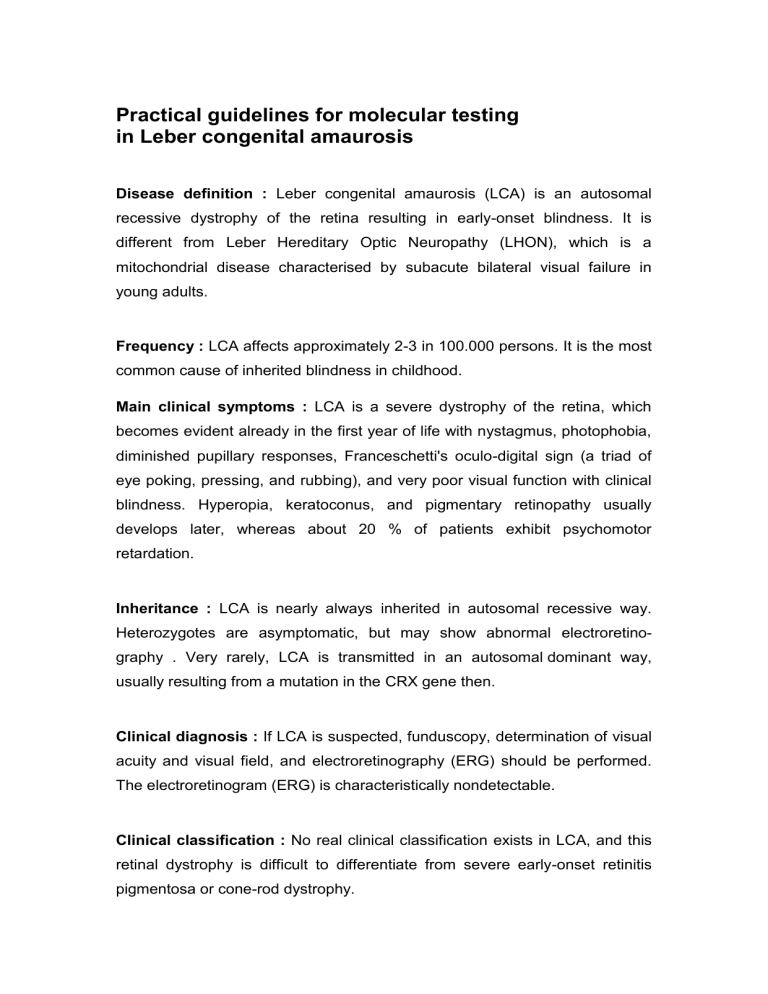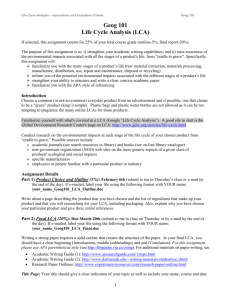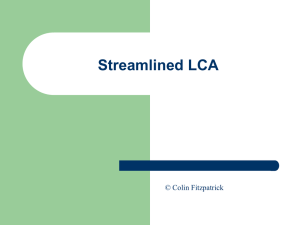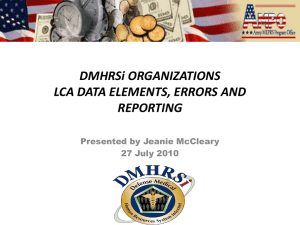Practical guidelines for molecular testing in Leber congenital

Practical guidelines for molecular testing in Leber congenital amaurosis
Disease definition : Leber congenital amaurosis (LCA) is an autosomal recessive dystrophy of the retina resulting in early-onset blindness. It is different from Leber Hereditary Optic Neuropathy (LHON), which is a mitochondrial disease characterised by subacute bilateral visual failure in young adults.
Frequency : LCA affects approximately 2-3 in 100.000 persons. It is the most common cause of inherited blindness in childhood.
Main clinical symptoms : LCA is a severe dystrophy of the retina, which becomes evident already in the first year of life with nystagmus, photophobia, diminished pupillary responses, Franceschetti's oculo-digital sign (a triad of eye poking, pressing, and rubbing), and very poor visual function with clinical blindness. Hyperopia, keratoconus, and pigmentary retinopathy usually develops later, whereas about 20 % of patients exhibit psychomotor retardation.
Inheritance : LCA is nearly always inherited in autosomal recessive way.
Heterozygotes are asymptomatic, but may show abnormal electroretinography . Very rarely, LCA is transmitted in an autosomal dominant way, usually resulting from a mutation in the CRX gene then.
Clinical diagnosis : If LCA is suspected, funduscopy, determination of visual acuity and visual field, and electroretinography (ERG) should be performed.
The electroretinogram (ERG) is characteristically nondetectable.
Clinical classification : No real clinical classification exists in LCA, and this retinal dystrophy is difficult to differentiate from severe early-onset retinitis pigmentosa or cone-rod dystrophy.
Molecular testing : Up to now more than 11 loci with 8 nuclear genes AIPL1,
CEP290, CRB1, CRX, GUCY2D, RDH12, RPE65, and RPGRIP1 have been shown to be implicated in LCA. Additional genes, including TULP1, MERTK,
LRAT and IMPDH1 are implicated in LCA-like entities (Table 1). These genes harbour more than 40 % of all LCA mutations. Molecular testing is complicated by this genetic heterogeneity and the large size of the 2 most common disease genes GUCY2D and CEP290, making testing rather expensive. Furthermore, there are no real mutation hot spots, apart from the
W278X mutation in AIPL1, which occurs in 25 % of mutant AIPL1 alleles, but in few mutant LCA alleles overall.
However, a microarray-based test of more than 400 mutations in all 8 LCA disease genes (AIPL1, CRB1, CRX, GUCY2D, CEP290, RDH12, RPGRIP1 and RPE65), and 3 LCA-like genes (LRAT, TULP1, MERTK) is available. As this test detects around 30 % of mutations in LCA, it is the first-pass screening tool.
Most genes implicated in LCA are also involved in in other retinal dystrophies, including retinitis pigmentosa and cone-rod dystrophy. These less severe retinal dystrophies are sometimes a consequence of specific mutations, or result when only 1 (dominant) mutation is present. Whereas 20 % of LCA patients has psychomotor retardation, also real syndromic forms of LCA, including Joubert, Meckel and Senior-Loken syndrome, may develop, especially in the case of CEP290 mutations.
References
Yzer S, Leroy BP, De Baere E, de Ravel TJ, Zonneveld MN, Voesenek K,
Kellner U, Ciriano JP, de Faber JT, Rohrschneider K, Roepman R, den
Hollander AI, Cruysberg JR, Meire F, Casteels I, van Moll-Ramirez NG,
Allikmets R, van den Born LI, Cremers FP. Microarray-based mutation detection and phenotypic characterization of patients with Leber congenital amaurosis. Invest Ophthalmol Vis Sci 2006: 47:1167-1176.
Hanein S, Perrault I, Gerber S, Tanguy G, Barbet F, Ducroq D, Calvas P,
Dollfus H, Hamel C, Lopponen T, Munier F, Santos L, Shalev S, Zafeiriou D,
Dufier JL, Munnich A, Rozet JM, Kaplan J. Leber congenital amaurosis: comprehensive survey of the genetic heterogeneity, refinement of the clinical definition, and genotype-phenotype correlations as a strategy for molecular diagnosis. Hum Mutat. 2004: 23: 306-317.
Cremers FP, van den Hurk JA, den Hollander AI. Molecular genetics of Leber congenital amaurosis. Hum Mol Genet 2002: 11: 1169-1176.
Databases
Retina-international database: www.retina-international.org
HUGO mutation database Initiative: www.hgvs.org
HGMD database : www.hgmd.cf.ac.uk
Type
Table 1. Different types of LCA with the proportion of the respective gene, its size, price indication, and test advise.
Specific feature Gene Protein Gene contribution (%)
Number of exons (AA)
Price indication (Euro)
20 exons
(1103 AA)
Test
Advise
Test 2 LCA
All cases
Also RP and CRD
Also Joubert, Meckel and
Senior-loken syndrome
Also RP
Also CRD and RP
Also CRD and RP
Also CRD
LCA- like
Also RP and pigmented paravenous chorioretinal atrophy
Mainly RP
Mainly RP
Also RP
GUCY2D (LCA1)
CEP290 (LCA10)
RPE65 (LCA2)
RDH12
AIPL1 (LCA4)
CRX (LCA8)
RPGRIP1 ( LCA6)
CRB1 (LCA7)
LRAT
TULP1
MERTK
IMPDH1
AIPL1, CRB1, CRX,
LRAT, GUCY2D,
CEP290, RDH12,
RPGRIP1, RPE65,
TULP1, MERTK
Retinal guanylyl cyclase 1
Centrosomal protein Cep290
Retinal pigment epitheliumspecific 65 kDa protein
Retinol dehydrogenase 12
Aryl-hydrocarbon-interacting protein-like 1
Cone-rod homeobox protein
X-linked retinitis pigmentosa
GTPase regulator-interacting protein 1
Crumbs homolog 1
Lecithin retinol acyltransferase
Tubby-like protein 1
Mer tyrosine kinase protooncogene
Imp dehydrogenase 1
Various
1-2
30
4
4-8
3
5
5-15
6-21
10-20
3-16
55 exons
(2481 AA)
14 exons
(555 AA)
7 exons
(316 AA)
5 exons
(321 AA)
4 exons
(299 AA)
24 exons
(1286 AA)
6 exons
(674 AA)
3000
450
570
900
1275
3 exons
(230 AA)
15 exons
(542 AA)
19 exons
(999 AA)
17 exons
(599 AA)
Mutations in
11 genes
200
800
600
No test advised
Test 4
No test advised
No test advised
No test advised
No test advised
Test 3
No test advised
No test advised
No test advised
No test advised
Test 1
.
Figure 1. Suggested molecular testing in LCA






